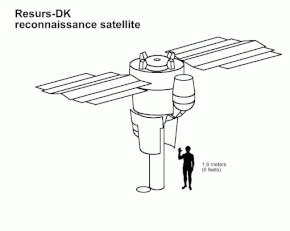|
Resurs-DK No.1
Resurs-DK No.1,[7] also called Resurs-DK1, was a commercial Earth observation satellite capable of transmitting high-resolution imagery (up to 0.9 m) to the ground stations as it passed overhead. The spacecraft was operated by NTs OMZ, the Russian Research Center for Earth Operative Monitoring. The satellite was designed for multi-spectral remote sensing of the Earth's surface aimed at acquiring high-quality visible images in near real-time as well as on-line data delivery via radio link and providing a wide range of consumers with value-added processed data. The Russian space tracking service, ASPOS OKP, reported that the spacecraft's onboard systems and attitude control had been terminated in February 2016. Tracking of the satellite was discontinued on 1 March 2016.[2] SpacecraftThe Resurs-DK spacecraft was built by the Russian space company TsSKB-Progress in Samara, Russia. It was a modified version of the military reconnaissance satellite Yantar-4KS1 (Terilen).[8] The spacecraft was three-axis stabilized. The design lifetime was no less than three years, with an expected lifetime of five years. Ground location accuracy was 100 m (330 ft). Onboard storage was 768 gigabits. Data link speed to the ground station was 300 Mbit/s. Maximum daily productivity was 1,000,000 km2 (390,000 sq mi). Resurs is Russian for "Resource". The letters DK are the initials of Dmitry Kozlov, chief designer of the first satellite of the Yantar-2K class. Optical subsystem
Made by Vavilov State Optical Institute, Russia [1] Archived 3 March 2016 at the Wayback Machine. Spectral Resolution
It was not possible to represent an image in true-color because there was no blue band (0.4 - 0.5 μm). However, it was possible to combine red, green and near infrared in such way that the appearance of the displayed image resembles a visible colour photograph, i.e. vegetation in green, water in blue, soil in brown. This was not always possible because two similarly coloured objects can have completely different reactions to near IR light. Green, red and near IR are typically combined to make a traditional false color composite where the near IR is displayed in red, the red is displayed in green, and the green is displayed in blue. This combination is favoured by scientists because near IR is useful for detection of numerous vegetation types. Vegetation appear as redtones, the brighter the red, the healthier the vegetation. Soils with no or sparse vegetation range from white (sand, salt) to greens or browns depending on moisture and organic matter content. Water appears blue, clear water is dark blue to black while shallow waters or waters with high sediment concentrations are lighter blue. Urban areas will appear blue towards gray. Clouds and snow are white. Focal Plane Unit Unit featured 4 TDI (Time Delay and Integration) sensor arrays, one panchromatic and three multispectral. Each sensor array was composed of 36 "Kruiz" CCD chips. Effective length of the single array was about 36000 pixels. Arrays were grouped in 3 separated lines:
This separation was causing a time delay of the colour images combined from green, red and near infrared, so fast-moving objects were shown in triplets. Moving object speed and direction could be calculated. All 4 arrays could work simultaneously, so it was possible to combine panchromatic and 3 multispectral images in one pansharpened color composite. The system used 10-bit analog-to-digital converters. Focal Plane Unit was made by NPO Opteks, Russia [2]. CCDThe CCD "Kruiz" was a 1024 pixel x 128 line, high speed TDI sensor. The active imaging area was organized as 1024 vertical columns and 128 horizontal TDI rows. [3][permanent dead link]
Spatial resolutionPanchromaticAt the altitude of 360 km:
At the altitude of 604 km:
Multispectral1.5–2.0 m [4] Temporal resolutionThe revisit rate was 5 to 7 days off-nadir. SwathSwath width at the altitude of 350 km:
ARINARussian research hardware for detection of high-energy electrons and protons, their identification, detection of high-energy particle bursts – earthquake signs.
PAMELAPAMELA, Payload for Antimatter Matter Exploration and Light-nuclei Astrophysics was an attached module built by Italian researchers with international partners. Its purpose was basic physics research of primary cosmic rays.
Major tasks
Major orbit changeThe satellite was initially placed in a 355 km × 573 km (221 mi × 356 mi) orbit in 2006. On 10 September 2010, its orbit was circularised to 567 km × 573 km (352 mi × 356 mi), with an inclination of 69.9°. See alsoReferences
External links |
||||||||||||||||||||||||||||||||||||||||||||||||||||||||||||||||||||||||||

